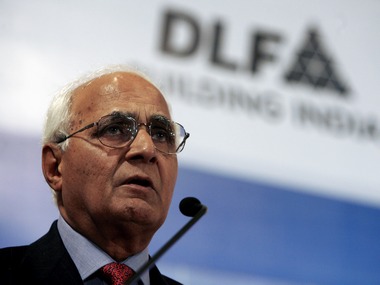The government’s recently announced retail reforms seem to have provided the much-need impetus for big realty players whosecommercialretail plans were going nowhere in the past couple of years because of dwindling demand.
DLF, the country’s largest real estate company, is already planning to kick start the largest mall in India, which is to come up in2015-16 in Gurgaon_._The firm is hoping that by then quite a few new retailers and brands would have entered the country.
While the government’s move toopen up both single and multi-brand retail for foreign players will push up the stocks in the short term, their overall fundamental and structural problems of high debt and lower liquidity are still not solved.
The DLF stock alone has rallied 12 percent since the reforms were announced while the BSE realty index has gone up by 14 percent in the same period.
[caption id=“attachment_467518” align=“alignleft” width=“380”]  DLF success story is largely concentrated in Gurgaon where the market is highly speculative.Reuters[/caption]
A report by brokerage Motilal Oswal says DLF is thebiggest beneficiary of 51% FDI in multi-brand retail as it has almost 20-22 million square feetpoisedfor retail development. “We expect a significant revival in its retail expansion plan over medium term, which has strongpotential to augment its annuity income (estimated at Rs 2000 crore in FY13), along with uptick in rental values existing assets.”
The brokerage has a buy rating on the stock with a target price of Rs 286 as it expects the company’s large divestments in Aman Resorts ( for Rs 1700-1800 crore) and Wind Mill business ( for Rs 900 crore) to be the next big triggers in the second half of financial year 2013. Moreovoer, the successful launch of super-luxury Magnolia II in NCR may result in higher-than-expected debt reduction for DLF.
However, DLF has been in the market for a long time to sell assets and bring down debt.This is because its pan-India expansion plans have been undermined by highlyleveraged balance sheets, high borrowing costs and slower execution. DLF still earns almost 30% of its revenues from Gurgaon despite its presence in over 20 cities. As a Firstpost article argued earlier,the 17-acre central Mumbai NTC land deal with Lodha for Rs 2,700 was more like a near distress sale. “Of the total deal price of Rs 2,727 crore, Rs 1,500 crore is debt. DLF will get only around Rs 1,227 crore in cash. Its Rs 702 crore investment has not even doubled in seven years. It’s gone up around 75 percent. A debt fund giving you 9-10 percent per annum would have doubled your money in the same time,” Firstpost had argued here .
Secondly, the DLF success story is largely concentrated in Gurgaon where the market is highly speculative.
Third, when the going was good, DLF went overboard with its big bang projects in various cities, many of which still remain stalled. It also exit several projects such as buildingmega townships in Bidadi, Karnataka and Dankuni, West Bengal.Property tends to be a local business in India and most developers stick to home markets, where they own land and know the bureaucracy. DLF and a few others like Unitech and Indiabulls Real Estate had more sprawling ambitions, which ultimately failed and resulted in more debt and lesser cash flows.
The biggest worry, however, is its Rs 22,000 cr debt pile. For the past couple of quarters, the company’s cash flows haven’t been enough to meet the interest cost of the debt.The company pays over one-fifth of its revenue to service the debt. It has become difficult for the company to alleviate the problem due to adverse economic factors like high interest rates, paucity of funds and subdued volumes as buyers defer purchases.
And last, the DLF stock price has been severely impacted by various legal conflicts, viz, CCI penalty of Rs 630 crore, income-tax claims of Rs 3,500 crore owing to DAL SEZ assets, etc. According toVeritas, Canadian-based research firm, DLF has undertaken questionable related-party transactions to boost the value of DAL prior to its acquisition by DLF, thereby subverting the interests of minority shareholders via a higher purchase price for DAL.
The proceedings for this would be long-drawn, and are unlikely to reach any conclusions over the near term.
So while analysts may turn bullish on the stock in the short term, DLF’s long-term troubles are still far from over.


)
)
)
)
)
)
)
)
)



